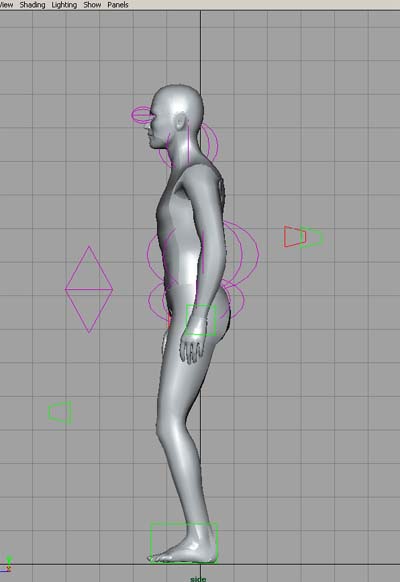
In this tutorial, we will go over the basic steps on how to animate a character jumping from one spot to another with one foot following the other.
You can think of this as a "leap" or somewhere between a run step and a jump. In the air, the legs are staggered.
You want to think of the same principles we applied to all exercises before this when animating this jump. The squash and stretch of this jump will not be as dramatic as in the two-footed jump, but it is definitely a must. Again, think about how light or heavy your character is, and make sure that is conveyed through your animation.
In this tutorial, we will again be using the Pose to Pose method of blocking out the animation.
Starting Pose
We start with the same relaxed pose that we used in the two-footed jump tutorial.

Squat before jump
Depending on how far you want your character to jump, and also how heavy your character is, this pose will vary. Adam will jump a decent distance, say 100 units, but not very high. Our starting squat won't be as extreme as the one we used in the two footed jump. The arms are back and up a bit, the root is down, and the torso is leaned forward. We've placed this pose at frame 21.
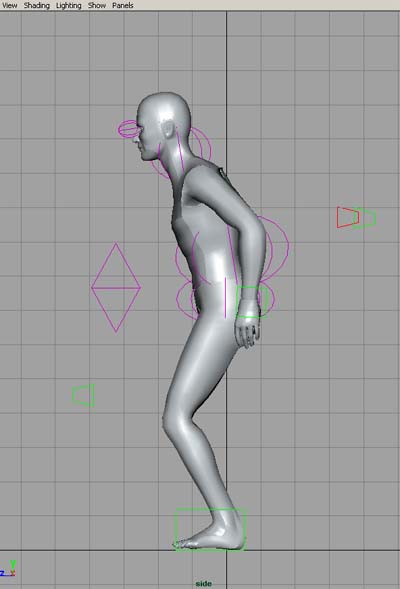
Take off pose
This pose is very similar to the pose in the run cycle where Adam's rear leg is about to leave the ground. Think about the "line of action" when you're posing. In these animations where your character is moving up and forward, the line of action will determine exactly which direction it is heading. We've chosen to jump with the left leg first. The left knee and right arm are providing momentum for the jump, and are out in front.
The hips are rotated such that the left hip is forward so that the left leg can extend. The torso is similarly rotated, with the right shoulder forward to follow the right arm.
We've also rotated the neck a bit to have Adam look a bit more upward to help him jump. We've set this pose at frame 27.

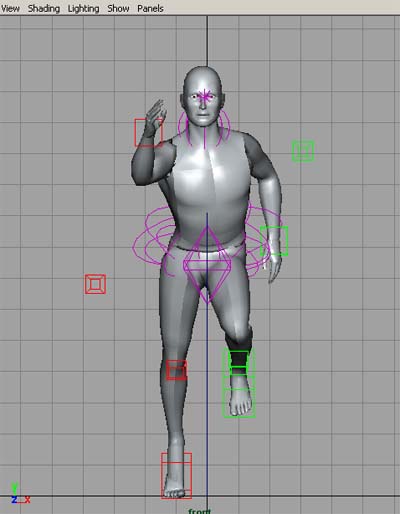
We have once again drawn a path for our trajectory.

Mid-Air
Again, this is similar to the mid-air pose in the run cycle. The front leg may be slightly more outstretched, depending on how much ground you want your character to clear. The root is translated up. The rear leg is brought forward and up, and rotated in the positive X-direction. We've placed this pose another six frames later at frame 33.

Pre-Landing
Yet another pose that is similar to the run cycle. The main difference is that Adam is not leaned as far forward. In the run, the character needs to keep it's forward momentum to continue moving. However, in this animation, the character wants to stop in the landing spot, so before landing, Adam must lean back a bit (like in the two-footed jump). We've set this pose at frame 39.
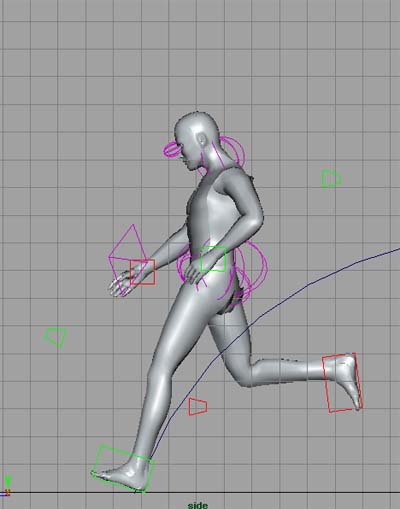
Landing
Just like in the previous jump, Adam must absorb the impact of landing. Since Adam's jump was not as high as in the two-footed jump, his compression is not as extreme as it was then. Adam's torso is leaned forward from the momentum, his back is curled forward, the head is looking towards the ground, and both feet are now flat on the ground. We've moved the arms forward as well. This pose is set at frame 45.

Recovery
The recovery pose is just the relaxed pose once again. It's the animation between the landing and the recovery that is most important. We will discuss that in a later section. We've placed this pose at frame 60.

Examples of the animation thus far: Side, Front, and Top.
Things to keep in mind and function curve comparisons
By this point in your exercises, you should be getting a good feel for what needs to be fixed in your animation. Keep in mind ALL the principles of animation you have learned about, and the techniques you've used in the previous exercises to apply them. We will briefly cover what has been done in this version as well.
Also added to the arms is a look of "anticipation". As Adam gets ready for this jump, his arms move into motion.

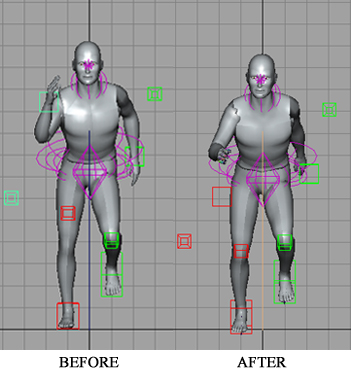
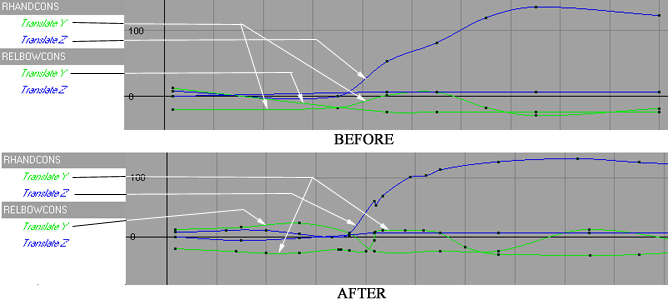
Something to keep in mind is the importance of arcs and paths of motion in your animation. The hands and feet in particular should travel on smooth arcs. This adds to the appeal of your animation. The same principles can be applied to the head, shoulders, and waist throughout the animation. *BARBARA, YOU CAN ADD SOMETHING HERE*
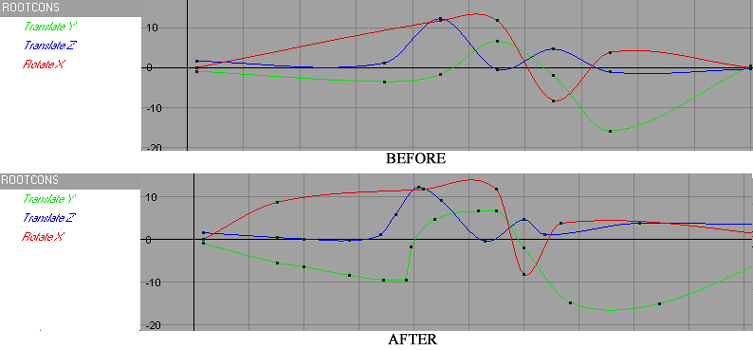
We needed more time during Adam's mid-air direction change from up to down. Also, we've added holds on the squat before the takeoff and during the recovery when Adam is at his lowest point.
Another important timing point is when Adam takes off. He is thrusting his body forward, so this would be the fastest Adam is moving forward, slowing down once his feet have left the ground. We have adjusted for this.
A note on "baking" in keys.
At the end of the animation, we want the arms to hang down pretty
loosely. This is hard to accomplish with IK while the root is
moving. The arms look strange. One solution is to "bake"
the rotations into the shoulders and elbows, and use Forward Kinematics.
To bake in rotations, select the joint you want to key, and select
Edit->Keys->Bake Simulation. A key will be set on the shoulder
rotations for every frame. It can be tedious to edit the curves, but often
you can achieve the desired results in less time. For this animation, we
wanted forward kinematics for select parts of the animation, so if you examine
the function curves, you can see that many of the keys were deleted only in
specific areas, in order to better manipulate the curves. Early on in the
animation, the function curves still have the many keys set on them.
For this exercise, create a cube that is a little past knee height for your character. Make sure that the top of the cube has enough room for your character to land on. When you're placing your cube, think about the trajectory you want your character to follow to get on top of the cube. We've drawn out trajectories below. Depending on your character's abilities, you will want to vary these.

By now, you should be quite familiar with posing your character, and which controls to use to get the character as you like. For the remainder of this tutorial, we will simply show example poses and example frame numbers to set the poses at. Also, many of the poses below are very similar to the regular jump poses.
Preparation
Here is the preparation pose. Since Adam is jumping with one foot in front of the other, his power is going to come from a combination of his lag foot jumping off the ground as well as his lead foot swinging forward and upward. This is set at frame 22. Prior to this setting, you'll have to remember to animate Adam anticipating the jump.
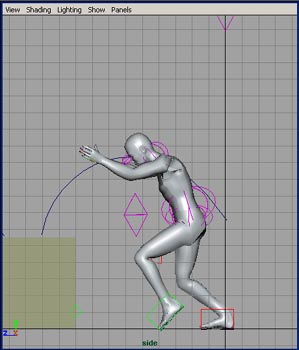
Takeoff
The takeoff is set at frame 24. This is a fast action where Adam is swinging his arms and lead foot quickly forward and upward. His lag leg is pushing him off the ground. Be sure that his front toes and knees clear the edge of the box (ie, they don't go through it).

Mid-Air
Here is the mid-air pose. We've set keyframes for this pose at frame 28.

Pre-Landing
This pose has been set at 30. Because Adam has to land on the box, which is closer to his high point in the air, his leg remains bent. This is different than the pre landing pose in the regular jump. Notice his lag leg is still straight.

The Landing
This pose is set at fame 36. One thing to notice about this landing is that Adam's lead leg is taking all the force of the landing on the box. His body compresses, his lag leg isn't as straight, and he's absorbing more on one leg than he might have done with two legs.

Recovery
His recovery is posed in two parts. The first part is framed at 55. The timing between the landing and the recovery is important as usual. The time it takes Adam to recover from the jump depends upon how he stands up. For this tutorial, we imagine him recovering by standing up on one leg as his lag leg comes to his side. So not only is he using one leg to stand, but he is balancing on one leg as well. In the front view, you can notice a few things. His ROOTCON isn't straight up and down and is moved over towards his anchor leg. This pose would be different if you choose to have Adam place his lag foot on the box immediately after landing so both legs can push him up to a standing position. You can also see from the front view that Adam is using his arms to help him balance as he stands up. This is not very visible from the side view so remember to always look at your animation from all sides to obtain the most realistic animation.

Be careful that his lag foot doesn't go through the box when Adam is brought up to the box.
We've set this rest pose at frame 71.

We've left some time between the last pose we used in the portion where Adam jumped onto the box, and the start of this portion. We do this in case we want to easily add to the previous animation, or to the beginning of this animation when we're through, it's basically a "cushion".
Preparation
We set this pose at frame 118. This gives us ample time to add some details, such as Adam looking down to spot his landing, and to give him some time to look like he's preparing to jump down. This makes Adam seem a bit pensive and careful, as he prepares to jump down. His lead foot is getting ready to lead off of the box.
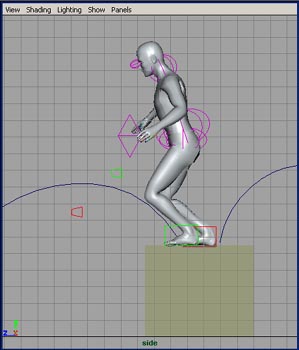
"Takeoff"
Adam does not need (or want) to jump high since he already has a larger drop to deal with. This pose is at frame 122. Adam is more "leaping" than "jumping" off the box, the difference being that he is leading with one leg. To prevent Adam from looking like he is simply stepping off the box, he must push off the box slightly with his lag leg, both forward and upward. His head is up and his chest is slightly out.
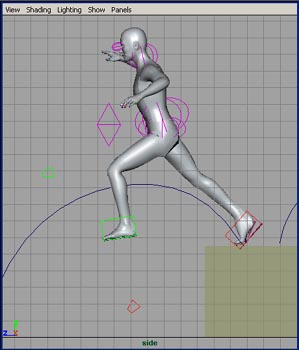
Mid-Air
Frame 127. Adam's arms are dragging. Both his legs are straight as his lead foot anticipates the ground and his lag foot has just come off the box.

Pre-Landing
Frame 130. The arms continue to drag and the lead leg is bent to prepare for impact. His lag leg has caught up and is brought forward faster to help take some of the force of the impact.

The Landing
Frame 138. His feet are planted at alternating times, each taking up some of the force of the landing. His lead leg makes the first contact to the ground and his lag leg comes up behind it, taking the remaining force of the impact.
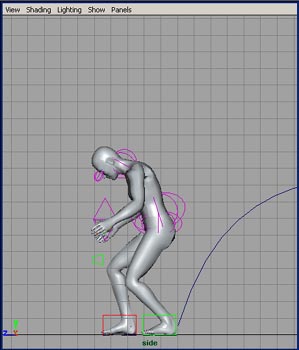
Recovery
Placing the key frame at 200 gives Adam plenty of time to recover from the jump, put his feet together, and to straighten up.

Tweaks and things to keep in mind.
Things that need to be tweaked are fairly similar to the standing jump. As before, timing and tweaking the key frames, among other things, are important to keep Adam from looking too robotic. Be sure to go through your checklist of things to pay attention to to get a better animation.
In our final version of the box jump, we've removed the arm constraints in order to use forward kinematics on the shoulders and elbows. This is a matter of preference and what you feel would make things easier for you as you animate.
Here is a version of the above animation complete with some tweaks and details added. Side, Front (with the box-semi-transparent), Top, and Perspective
Try the animation out with different height and width boxes. If the box is too low, then it'd make more sense for Adam to simply step up onto the box. If the box is too high, then his lead foot may not clear and he'll trip onto the top of the box. Or he may jump onto the box and fall right back onto the ground. If the box is too wide, then he will have to take a few steps before he can jump off to the other side. If it is too narrow, then he will have to check his balance even more as he lands on top and there may be more feet shifting. Again, be sure to try the action out yourself to see what you would do in varying situations.
Jason Ilano, 09/2000